Enhancement of a Graphene-Based Near-Field Thermophotovoltaic System by Optimization Algorithms and Dynamic Regulations
Abstract
1. Introduction
2. Materials and Methods
3. Results and Discussion
3.1. The Performance of Four Graphene-Based Cases
3.2. ITO Thickness and Plasma Frequency Optimized by Particle Swarm Optimization
3.3. Performance of Different Chemical Potentials of the Graphene
3.4. Comparison between Performances before and after Optimization
3.5. Performance of Different ITO Emitter Temperatures
3.6. Comparison of the Results above with Related Works
4. Conclusions
Supplementary Materials
Funding
Institutional Review Board Statement
Informed Consent Statement
Data Availability Statement
Acknowledgments
Conflicts of Interest
References
- Park, K.; Basu, S.; King, W.P.; Zhang, Z.M. Performance analysis of near-field thermophotovoltaic devices considering absorption distribution. J. Quant. Spectrosc. Radiat. Transf. 2008, 109, 305–316. [Google Scholar] [CrossRef]
- Ilic, O.; Jablan, M.; Joannopoulos, J.D.; Celanovic, I.; Soljačić, M. Overcoming the black body limit in plasmonic and graphene near-field thermophotovoltaic systems. Opt. Express 2012, 20, A366–A384. [Google Scholar] [CrossRef] [PubMed]
- Svetovoy, V.B.; Palasantzas, G. Graphene-on-Silicon Near-Field Thermophotovoltaic Cell. Phys. Rev. Appl. 2014, 2, 034006. [Google Scholar] [CrossRef]
- Chen, K.; Santhanam, P.; Sandhu, S.; Zhu, L.; Fan, S. Heat-flux control and solid-state cooling by regulating chemical potential of photons in near-field electromagnetic heat transfer. Phys. Rev. B 2015, 91, 134301. [Google Scholar] [CrossRef]
- Zhang, W.; Wang, B.; Zhao, C. Selective Thermophotovoltaic Emitter with Aperiodic Multilayer Structures Designed by Machine Learning. ACS Appl. Energy Mater. 2021, 4, 2004–2013. [Google Scholar] [CrossRef]
- Polder, D.; Van Hove, M. Theory of Radiative Heat Transfer between Closely Spaced Bodies. Phys. Rev. B 1971, 4, 3303–3314. [Google Scholar] [CrossRef]
- Krishnamurthy, S.; Berding, M.A. Full-band-structure calculation of Shockley–Read–Hall recombination rates in InAs. J. Appl. Phys. 2001, 90, 848–851. [Google Scholar] [CrossRef]
- Jablan, M.; Buljan, H.; Soljačić, M. Plasmonics in graphene at infrared frequencies. Phys. Rev. B 2009, 80, 245435. [Google Scholar] [CrossRef]
- Ilic, O.; Jablan, M.; Joannopoulos, J.D.; Celanovic, I.; Buljan, H.; Soljačić, M. Near-field thermal radiation transfer controlled by plasmons in graphene. Phys. Rev. B 2012, 85, 155422. [Google Scholar] [CrossRef]
- Messina, R.; Ben-Abdallah, P. Graphene-based photovoltaic cells for near-field thermal energy conversion. Sci. Rep. 2013, 3, 1383. [Google Scholar] [CrossRef]
- Molesky, S.; Jacob, Z. High temperature Epsilon-near-Zero and Epsilon-near-Pole metamaterial emitters for thermophotovoltaics. Opt. Express 2013, 21, A96–A110. [Google Scholar] [CrossRef] [PubMed]
- Lim, M.; Lee, S.S.; Lee, B.J. Effects of multilayered graphene on the performance of near-field thermophotovoltaic system at longer vacuum gap distances. J. Quant. Spectrosc. Radiat. Transf. 2017, 197, 84–94. [Google Scholar] [CrossRef]
- Lim, M.; Song, J.; Kim, J.; Lee, S.S.; Lee, I.; Lee, B.J. Optimization of a near-field thermophotovoltaic system operating at low temperature and large vacuum gap. J. Quant. Spectrosc. Radiat. Transf. 2018, 210, 35–43. [Google Scholar] [CrossRef]
- Wang, H.; Alshehri, H.; Su, H.; Wang, L. Design, fabrication and optical characterizations of large-area lithography-free ultrathin multilayer selective solar coatings with excellent thermal stability in air. Sol. Energy Mater. Sol. Cells 2018, 174, 445–452. [Google Scholar] [CrossRef]
- Sakurai, A.; Yada, K.; Simomura, T.; Ju, S.; Kashiwagi, M.; Okada, H.; Nagao, T.; Tsuda, K.; Shiomi, J. Ultranarrow-Band Wavelength-Selective Thermal Emission with Aperiodic Multilayered Metamaterials Designed by Bayesian Optimization. ACS Cent. Sci. 2019, 5, 319–326. [Google Scholar] [CrossRef] [PubMed]
- Chang, J.-Y.; Sabbaghi, P.; Wang, L. Near-field radiative heat transfer between nanowire-based dual uniaxial magneto-dielectric metamaterials. Int. J. Heat Mass Transf. 2020, 158, 120023. [Google Scholar] [CrossRef]
- Papadakis, G.T.; Buddhiraju, S.; Zhao, Z.; Zhao, B.; Fan, S. Broadening Near-Field Emission for Performance Enhancement in Thermophotovoltaics. Nano Lett. 2020, 20, 1654–1661. [Google Scholar] [CrossRef]
- Lucchesi, C.; Cakiroglu, D.; Perez, J.P.; Taliercio, T.; Tournie, E.; Chapuis, P.O.; Vaillon, R. Near-Field Thermophotovoltaic Conversion with High Electrical Power Density and Cell Efficiency above 14. Nano Lett. 2021, 21, 4524–4529. [Google Scholar] [CrossRef]
- Mittapally, R.; Lee, B.; Zhu, L.; Reihani, A.; Lim, J.W.; Fan, D.; Forrest, S.R.; Reddy, P.; Meyhofer, E. Near-field thermophotovoltaics for efficient heat to electricity conversion at high power density. Nat. Commun. 2021, 12, 4364. [Google Scholar] [CrossRef]
- Fiorino, A.; Zhu, L.; Thompson, D.; Mittapally, R.; Reddy, P.; Meyhofer, E. Nanogap near-field thermophotovoltaics. Nat. Nanotechnol. 2018, 13, 806–811. [Google Scholar] [CrossRef]
- Wu, X.; Fu, C. Near-field radiative heat transfer between uniaxial hyperbolic media: Role of volume and surface phonon polaritons. J. Quant. Spectrosc. Radiat. Transf. 2021, 258, 107337. [Google Scholar] [CrossRef]
- Zhang, W.; Wang, B.; Xu, J.; Zhao, C. High-quality quasi-monochromatic near-field radiative heat transfer designed by adaptive hybrid Bayesian optimization. Sci. China Technol. Sci. 2022, 65, 2910–2920. [Google Scholar] [CrossRef]
- Zhang, W.B.; Wang, B.X.; Zhao, C.Y. Active control and enhancement of near-field heat transfer between dissimilar materials by strong coupling effects. Int. J. Heat Mass Transf. 2022, 188, 122588. [Google Scholar] [CrossRef]
- Kittel, A.; Muller-Hirsch, W.; Parisi, J.; Biehs, S.A.; Reddig, D.; Holthaus, M. Near-field heat transfer in a scanning thermal microscope. Phys. Rev. Lett 2005, 95, 224301. [Google Scholar] [CrossRef] [PubMed]
- Laroche, M.; Carminati, R.; Greffet, J.J. Near-field thermophotovoltaic energy conversion. J. Appl. Phys. 2006, 100, 063704. [Google Scholar] [CrossRef]
- Shen, S.; Narayanaswamy, A.; Chen, G. Surface phonon polaritons mediated energy transfer between nanoscale gaps. Nano Lett. 2009, 9, 2909–2913. [Google Scholar] [CrossRef] [PubMed]
- Chang, J.-Y.; Yang, Y.; Wang, L. Tungsten nanowire based hyperbolic metamaterial emitters for near-field thermophotovoltaic applications. Int. J. Heat Mass Transf. 2015, 87, 237–247. [Google Scholar] [CrossRef]
- Zhang, X.; Chen, F.; Jiang, Y.; Yan, Y.; Yang, L.; Yang, L.; Wang, X.; Yu, C.; Hu, L.; Dai, Y.; et al. Graphene Oxide Modified Microtubular ZnO Antibacterial Agents for a Photocatalytic Filter in a Facial Mask. ACS Appl. Nano Mater. 2022, 5, 16332–16343. [Google Scholar] [CrossRef]
- van Zwol, P.J.; Thiele, S.; Berger, C.; de Heer, W.A.; Chevrier, J. Nanoscale radiative heat flow due to surface plasmons in graphene and doped silicon. Phys. Rev. Lett 2012, 109, 264301. [Google Scholar] [CrossRef]
- Lu, Q.; Zhou, X.; Krysa, A.; Marshall, A.; Carrington, P.; Tan, C.-H.; Krier, A. InAs thermophotovoltaic cells with high quantum efficiency for waste heat recovery applications below 1000 °C. Sol. Energy Mater. Sol. Cells 2018, 179, 334–338. [Google Scholar] [CrossRef]
- Beiranvand, B.; Sobolev, A.S.; Sheikhaleh, A. A proposal for a dual-band tunable plasmonic absorber using concentric-rings resonators and mono-layer graphene. Optik 2020, 223, 165587. [Google Scholar] [CrossRef]
- Beiranvand, B.; Sobolev, A.S. A proposal for a multi-functional tunable dual-band plasmonic absorber consisting of a periodic array of elliptical grooves. J. Opt. 2020, 22, 105005. [Google Scholar] [CrossRef]
- Svetovoy, V.B.; van Zwol, P.J.; Chevrier, J. Plasmon enhanced near-field radiative heat transfer for graphene covered dielectrics. Phys. Rev. B 2012, 85, 155418. [Google Scholar] [CrossRef]
- Liu, X.L.; Zhang, Z.M. Graphene-assisted near-field radiative heat transfer between corrugated polar materials. Appl. Phys. Lett. 2014, 104, 251911. [Google Scholar] [CrossRef]
- Zhao, Q.; Zhou, T.; Wang, T.; Liu, W.; Liu, J.; Yu, T.; Liao, Q.; Liu, N. Active control of near-field radiative heat transfer between graphene-covered metamaterials. J. Phys. D Appl. Phys. 2017, 50, 145101. [Google Scholar] [CrossRef]
- Khaleel, S.A.; Hamad, E.K.I.; Parchin, N.O.; Saleh, M.B. MTM-Inspired Graphene-Based THz MIMO Antenna Configurations Using Characteristic Mode Analysis for 6G/IoT Applications. Electronics 2022, 11, 2152. [Google Scholar] [CrossRef]
- Huang, J.; Wu, Y.; Su, B.; Liu, J. Preparation and Electrical Testing of Double Top Gate Graphene Field-Effect Transistor. Appl. Comput. Electromagn. Soc. J. (ACES) 2022, 37, 774–781. [Google Scholar] [CrossRef]
- Bashar, S.A.; Rezazadeh, A.A. Optically transparent ITO emitter contacts in the fabrication of InP/InGaAs HPT’s. IEEE Trans. Microw. Theory Tech. 1995, 43, 2299–2303. [Google Scholar] [CrossRef]
- Yang, Y.; Chang, J.-Y.; Sabbaghi, P.; Wang, L. Performance Analysis of a Near-Field Thermophotovoltaic Device With a Metallodielectric Selective Emitter and Electrical Contacts for the Photovoltaic Cell. J. Heat Transf. 2017, 139, 052701. [Google Scholar] [CrossRef]
- Li, H.; Guo, L.; Liu, X.; Sun, T.; Chen, Y. High Temperature Conductive Stability of Indium Tin Oxide Films. Front. Mater. 2020, 7, 113. [Google Scholar] [CrossRef]
- Huang, H.; Shan, S.; Zhou, Z. The performance analysis of near-field thermophotovoltaics considering temperature dependence of indium tin oxide emitter. Int. J. Therm. Sci. 2023, 184, 107909. [Google Scholar] [CrossRef]
- Zhao, B.; Chen, K.; Buddhiraju, S.; Bhatt, G.; Lipson, M.; Fan, S. High-performance near-field thermophotovoltaics for waste heat recovery. Nano Energy 2017, 41, 344–350. [Google Scholar] [CrossRef]
- Roy-Layinde, B.; Burger, T.; Fan, D.; Lee, B.; McSherry, S.; Forrest, S.R.; Lenert, A. Sustaining efficiency at elevated power densities in InGaAs airbridge thermophotovoltaic cells. Sol. Energy Mater. Sol. Cells 2022, 236, 111523. [Google Scholar] [CrossRef]
- Ikeda, T.; Ito, K.; Iizuka, H. Tunable quasi-monochromatic near-field radiative heat transfer in s and p polarizations by a hyperbolic metamaterial layer. J. Appl. Phys. 2017, 121, 13106. [Google Scholar] [CrossRef]
- Ito, K.; Nishikawa, K.; Miura, A.; Toshiyoshi, H.; Iizuka, H. Dynamic Modulation of Radiative Heat Transfer beyond the Blackbody Limit. Nano Lett. 2017, 17, 4347–4353. [Google Scholar] [CrossRef]
- Liu, X.L.; Bright, T.J.; Zhang, Z.M. Application Conditions of Effective Medium Theory in Near-Field Radiative Heat Transfer Between Multilayered Metamaterials. J. Heat Transf. 2014, 136, 092703. [Google Scholar] [CrossRef]
- Messina, R.; Hugonin, J.-P.; Greffet, J.-J.; Marquier, F.; De Wilde, Y.; Belarouci, A.; Frechette, L.; Cordier, Y.; Ben-Abdallah, P. Tuning the electromagnetic local density of states in graphene-covered systems via strong coupling with graphene plasmons. Phys. Rev. B 2013, 87, 085421. [Google Scholar] [CrossRef]
- Liu, P.Q.; Luxmoore, I.J.; Mikhailov, S.A.; Savostianova, N.A.; Valmorra, F.; Faist, J.; Nash, G.R. Highly tunable hybrid metamaterials employing split-ring resonators strongly coupled to graphene surface plasmons. Nat. Commun. 2015, 6, 8969. [Google Scholar] [CrossRef]
- Zhao, B.; Zhang, Z.M. Strong Plasmonic Coupling between Graphene Ribbon Array and Metal Gratings. ACS Photonics 2015, 2, 1611–1618. [Google Scholar] [CrossRef]
- Zhao, B.; Guizal, B.; Zhang, Z.M.; Fan, S.; Antezza, M. Near-field heat transfer between graphene/hBN multilayers. Phys. Rev. B 2017, 95, 245437. [Google Scholar] [CrossRef]
- Liu, X.; Zhang, R.Z.; Zhang, Z. Near-Perfect Photon Tunneling by Hybridizing Graphene Plasmons and Hyperbolic Modes. ACS Photonics 2014, 1, 785–789. [Google Scholar] [CrossRef]
- Zhang, W.B.; Zhao, C.Y.; Wang, B.X. Enhancing near-field heat transfer between composite structures through strongly coupled surface modes. Phys. Rev. B 2019, 100, 075425. [Google Scholar] [CrossRef]
- St-Gelais, R.; Bhatt, G.R.; Zhu, L.; Fan, S.; Lipson, M. Hot Carrier-Based Near-Field Thermophotovoltaic Energy Conversion. ACS Nano 2017, 11, 3001–3009. [Google Scholar] [CrossRef] [PubMed]
- Lim, M.; Jin, S.; Lee, S.S.; Lee, B.J. Graphene-assisted Si-InSb thermophotovoltaic system for low temperature applications. Opt. Express 2015, 23, A240–A253. [Google Scholar] [CrossRef] [PubMed]
- Deshamukhya, T.; Bhanja, D.; Nath, S.; Hazarika, S.A. Prediction of optimum design variables for maximum heat transfer through a rectangular porous fin using particle swarm optimization. J. Mech. Sci. Technol. 2018, 32, 4495–4502. [Google Scholar] [CrossRef]
- Ding, P. Solution of Inverse Convection Heat Transfer Problem Using an Enhanced Particle Swarm Optimization Algorithm. J. Heat Transf. 2012, 134, 011702. [Google Scholar] [CrossRef]
- Inoue, T.; Suzuki, T.; Ikeda, K.; Asano, T.; Noda, S. Near-field thermophotovotaic devices with surrounding non-contact reflectors for efficient photon recycling. Opt. Express 2021, 29, 11133–11143. [Google Scholar] [CrossRef]
- Feng, D.; Tervo, E.J.; Vasileska, D.; Yee, S.K.; Rohatgi, A.; Zhang, Z.M. Spatial profiles of photon chemical potential in near-field thermophotovoltaic cells. J. Appl. Phys. 2021, 129, 213101. [Google Scholar] [CrossRef]

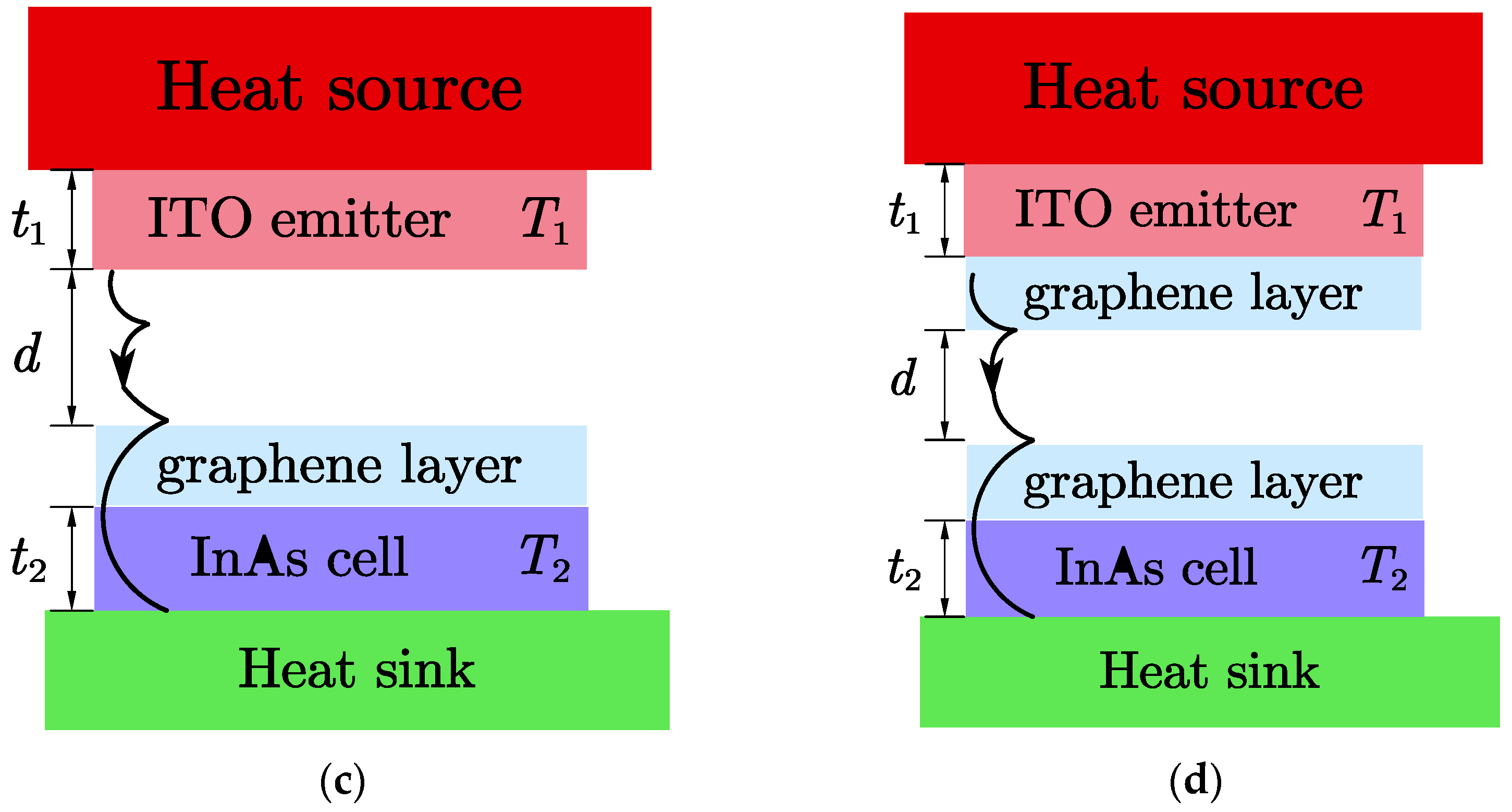
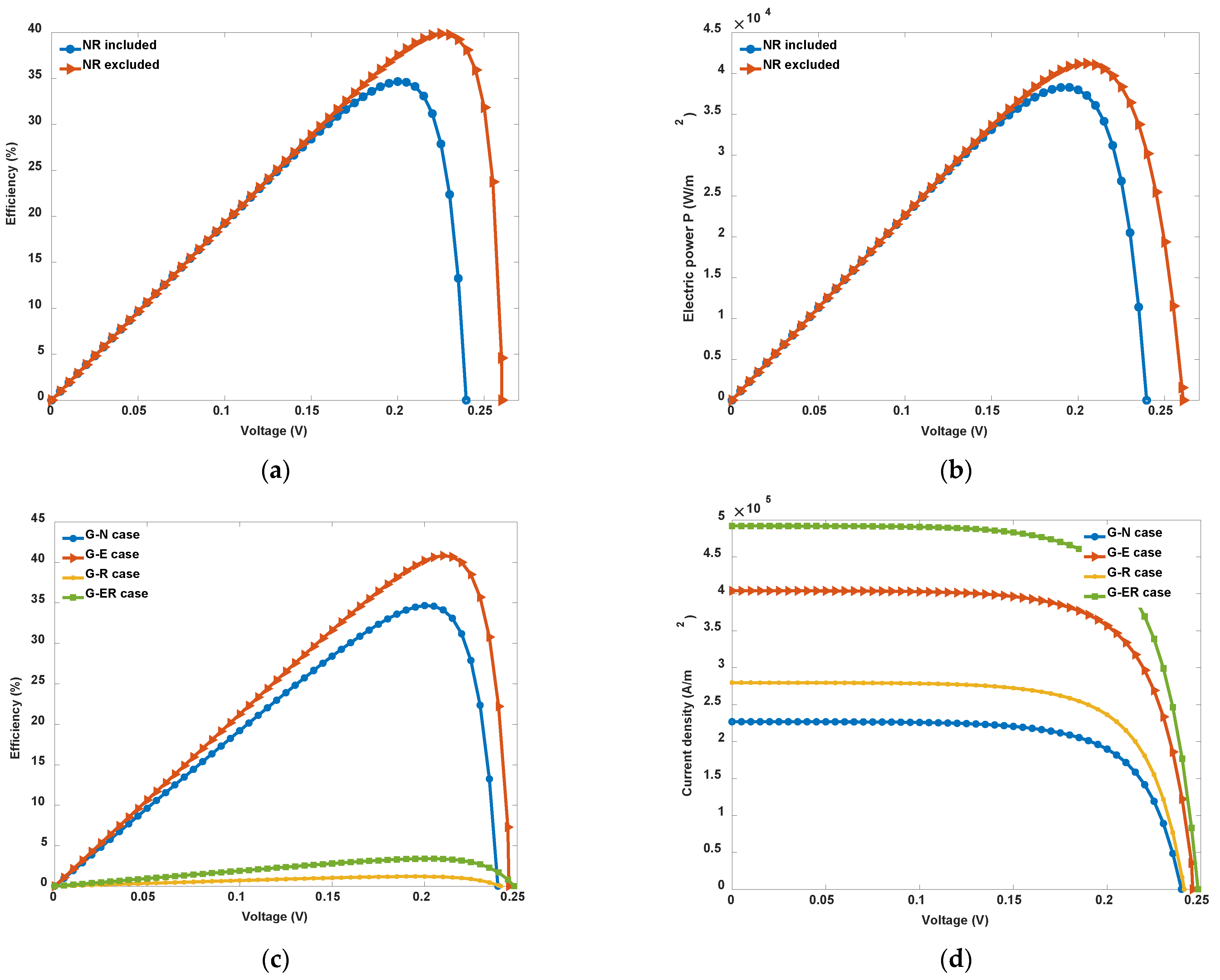
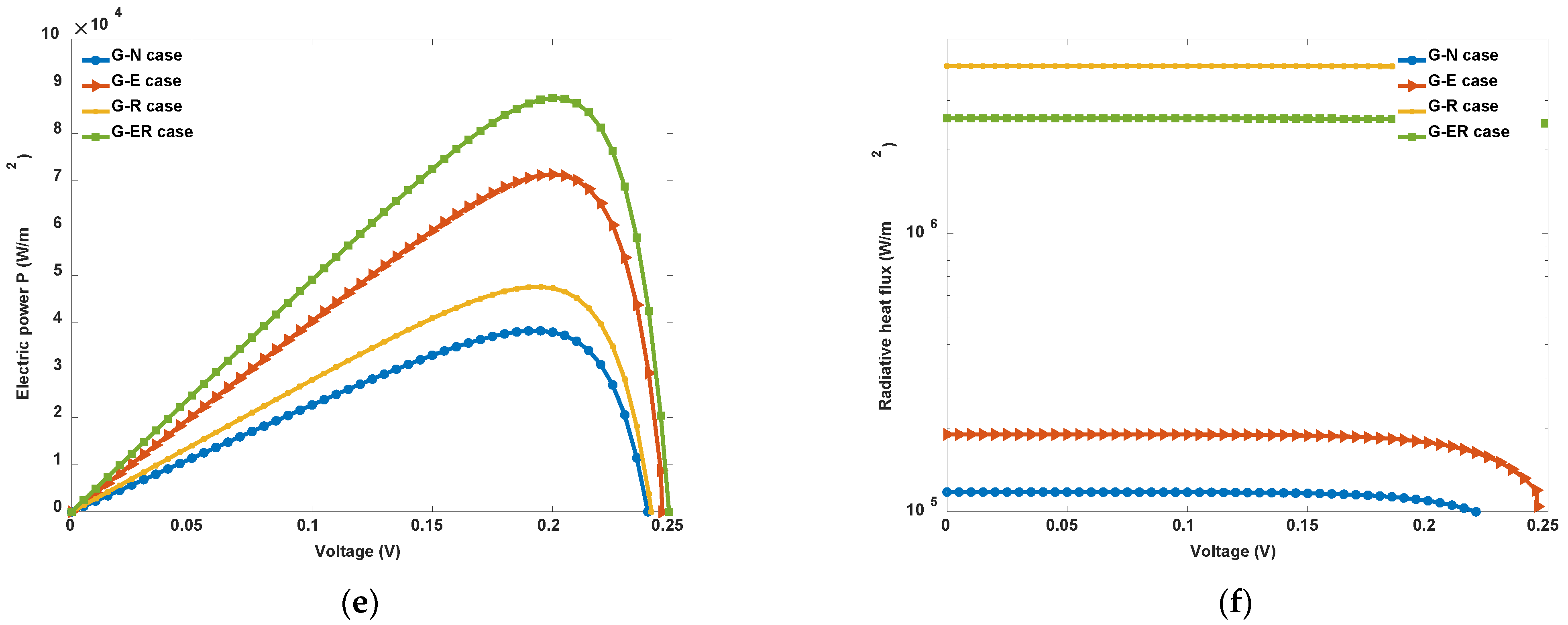
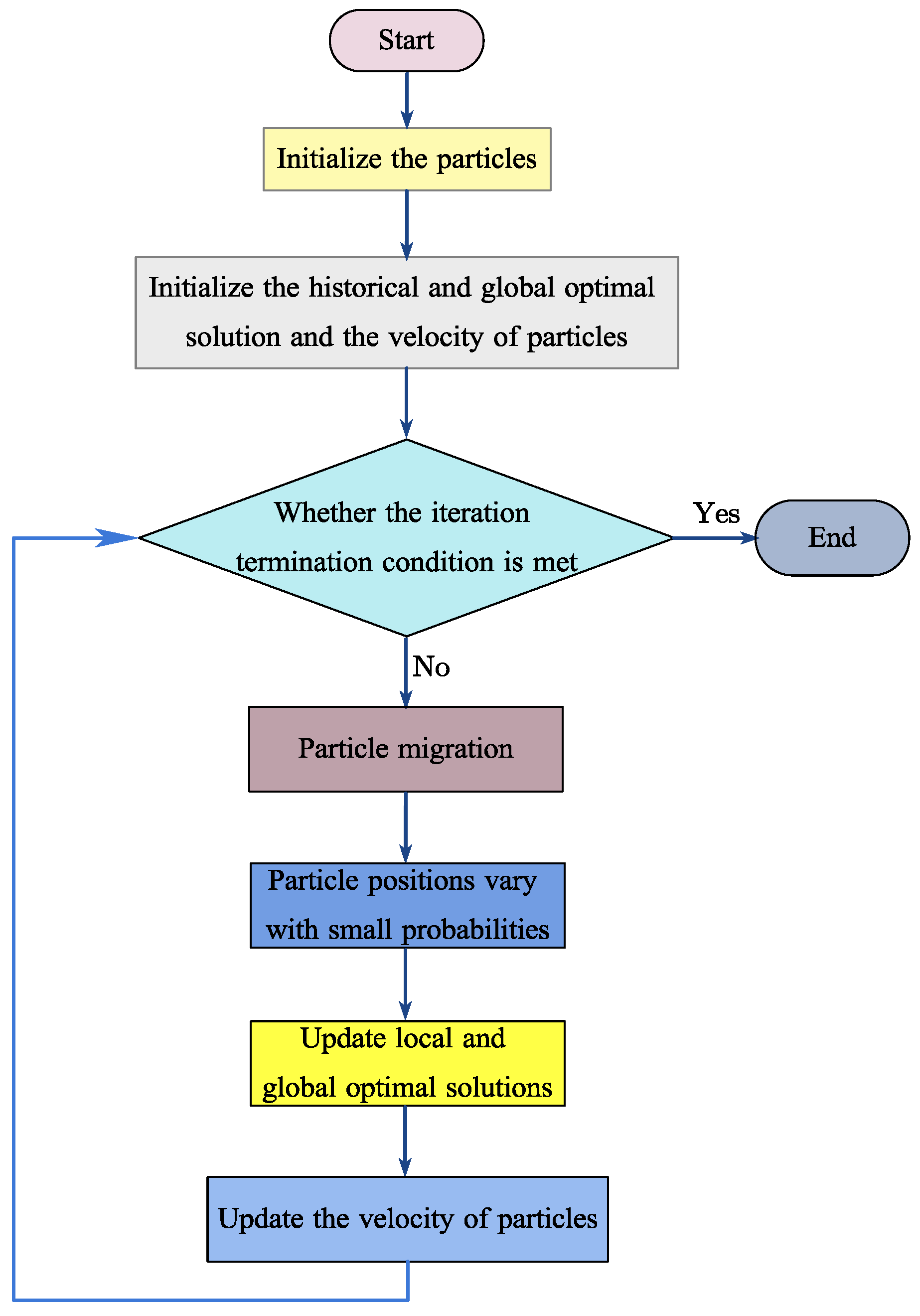
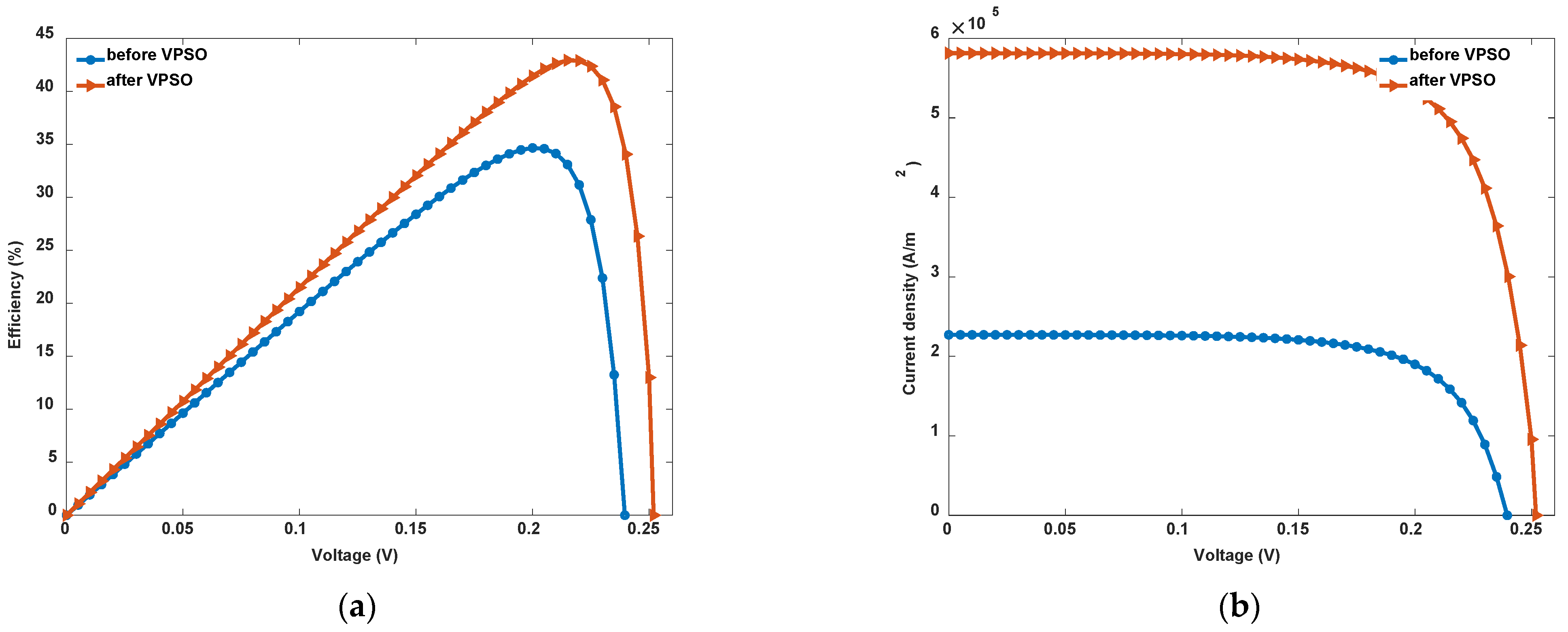

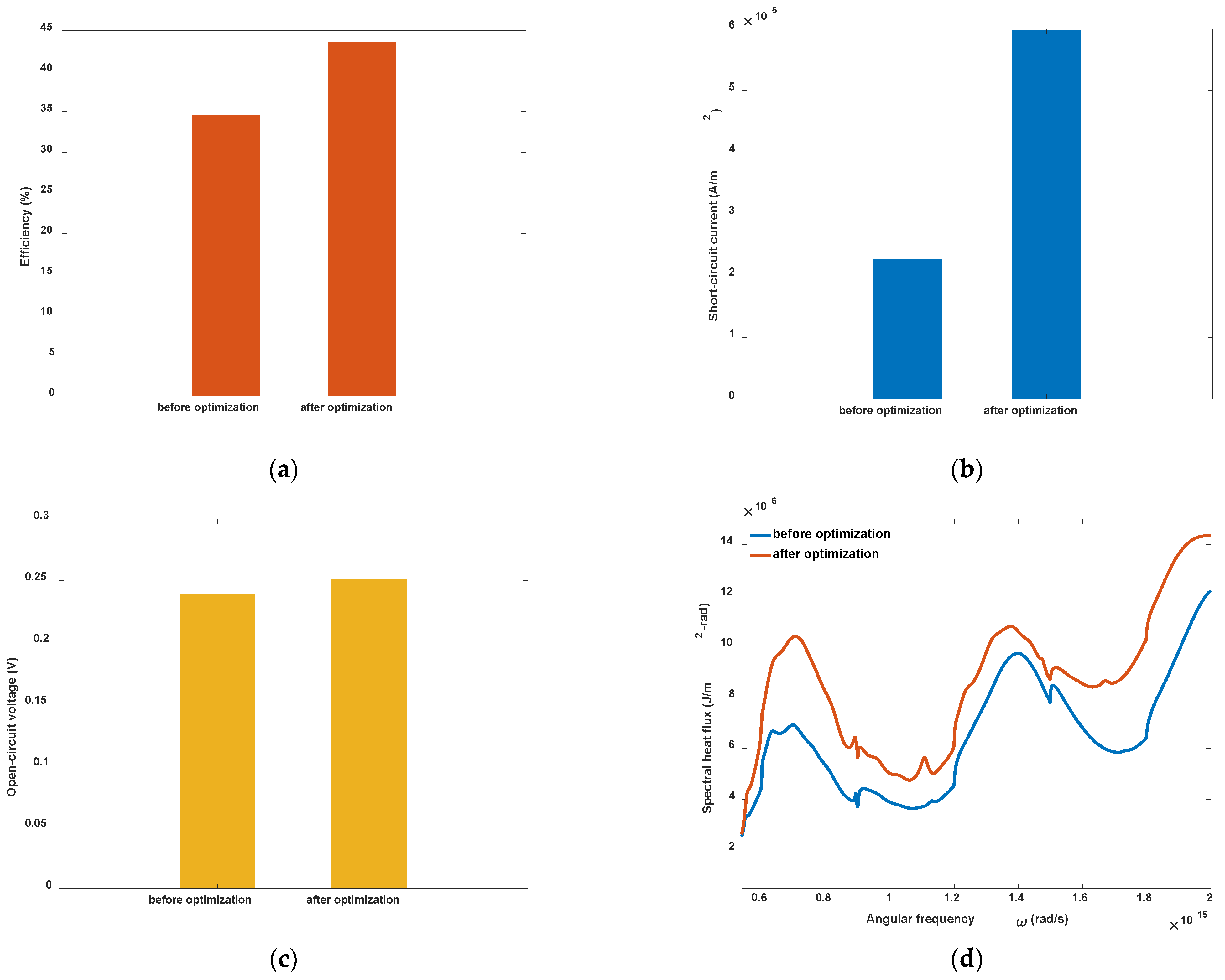

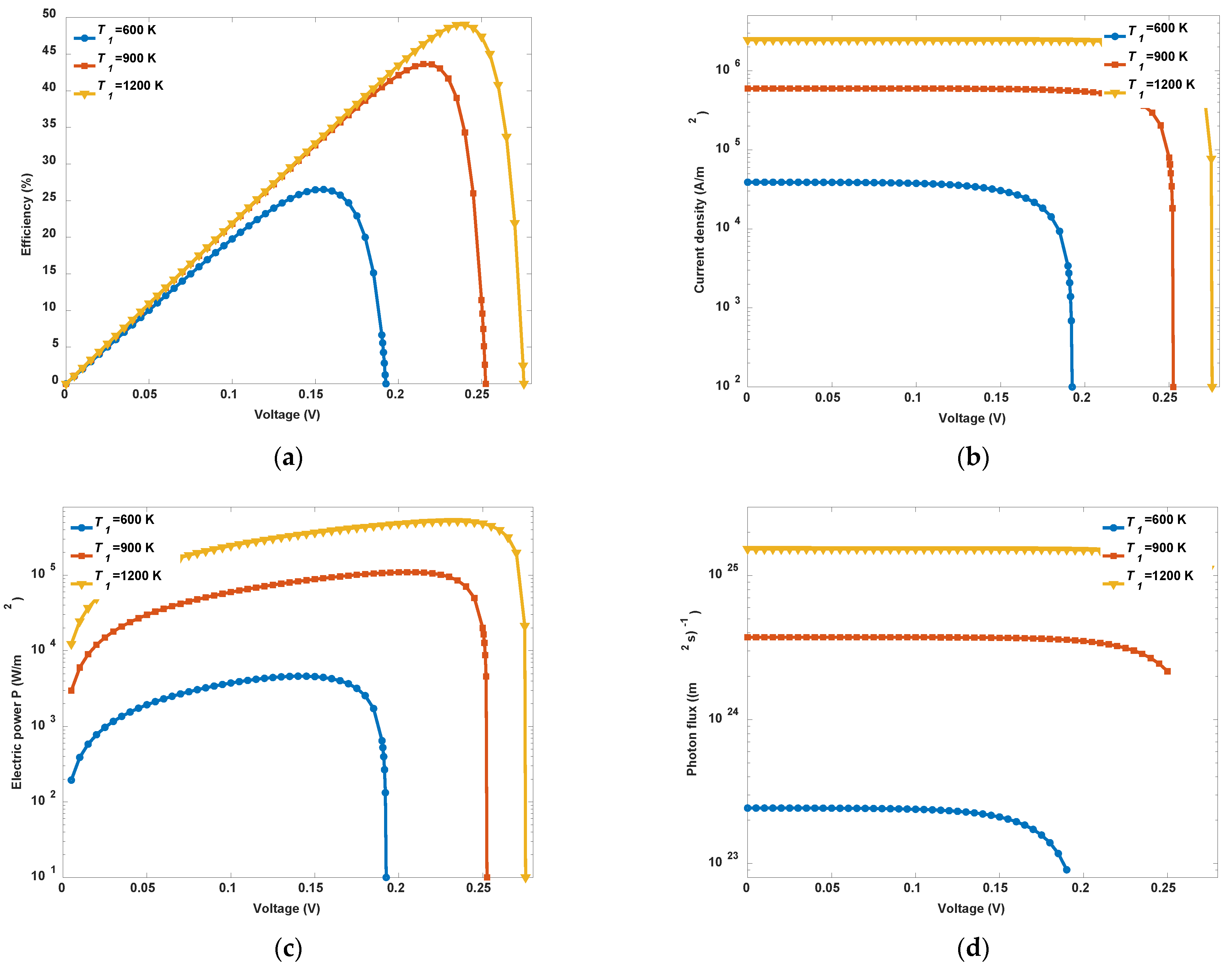
| Structure | NR Included or Not | Efficiency (%) | Electric Power (W/cm2) | Temperature Difference (K) | Ref |
|---|---|---|---|---|---|
| ITO InAs G-E | Yes | 43.63 | 11.2 | 600 | This work |
| ITO InAs G-E | No | 46.23 | 11.8 | 600 | This work |
| ITO InAs G-E | Yes | 49.04 | 52.0 | 900 | This work |
| ITO InAs G-E | No | 57.47 | 55.0 | 900 | This work |
| ITO InAs | Yes | 39.30 | 11.0 | 600 | [42] |
| Si InGaAs | No | 52.00 | 15.0 | 1100 | [57] |
| Tungsten In0.2Ga0.8Sb | No | 23.10 | 58.0 | 1700 | [27] |
| W-ITO InAs | Yes | 39.80 | 9.0 | 600 | [58] |
Disclaimer/Publisher’s Note: The statements, opinions and data contained in all publications are solely those of the individual author(s) and contributor(s) and not of MDPI and/or the editor(s). MDPI and/or the editor(s) disclaim responsibility for any injury to people or property resulting from any ideas, methods, instructions or products referred to in the content. |
© 2023 by the author. Licensee MDPI, Basel, Switzerland. This article is an open access article distributed under the terms and conditions of the Creative Commons Attribution (CC BY) license (https://creativecommons.org/licenses/by/4.0/).
Share and Cite
Sheng, Y. Enhancement of a Graphene-Based Near-Field Thermophotovoltaic System by Optimization Algorithms and Dynamic Regulations. Photonics 2023, 10, 137. https://doi.org/10.3390/photonics10020137
Sheng Y. Enhancement of a Graphene-Based Near-Field Thermophotovoltaic System by Optimization Algorithms and Dynamic Regulations. Photonics. 2023; 10(2):137. https://doi.org/10.3390/photonics10020137
Chicago/Turabian StyleSheng, Yitao. 2023. "Enhancement of a Graphene-Based Near-Field Thermophotovoltaic System by Optimization Algorithms and Dynamic Regulations" Photonics 10, no. 2: 137. https://doi.org/10.3390/photonics10020137
APA StyleSheng, Y. (2023). Enhancement of a Graphene-Based Near-Field Thermophotovoltaic System by Optimization Algorithms and Dynamic Regulations. Photonics, 10(2), 137. https://doi.org/10.3390/photonics10020137





